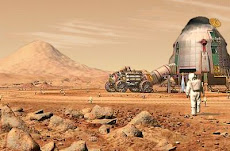
This NASA photo shows the Mars Science Laboratory rover, Curiosity, during testing June 3 at the Jet Propulsion Laboratory in Pasadena, Calif.
One of the most sophisticated space vehicles ever made inches along the rocky landscape, aluminum wheels grinding like a spoon in a garbage disposal.
Here in the Mars Yard at the Jet Propulsion Laboratory, what passes for the Red Planet looks like a vacant lot in Hesperia. The vehicle being tested, a replica of the latest Mars rover that will soon be crawling around up there, looks like a giant mechanical insect — six wheeled legs, an articulating arm and a pair of blue camera lenses like eyes peering from a boxy head.
On Friday, NASA's most ambitious Mars rover mission to date is scheduled to lift off from Cape Canaveral, Fla., aboard an Atlas V rocket. It's a $2.5 billion gamble scientists hope will give unparalleled insights into how Mars evolved and whether it ever could have supported life.T
The Mars Science Laboratory — nicknamed Curiosity — was developed at JPL in La Canada Flintridge, Calif., and will be the fourth rover to traverse the planet's harsh terrain. But unlike the earlier Mars rovers — Sojourner, Spirit and the still-cruising Opportunity — Curiosity will do more than look for evidence of water.
Curiosity is a robot astrobiologist. During a mission expected to last at least two years, the rover will use a battery of scientific instruments to analyze Mars' geology and atmosphere, looking for the elements and chemical compounds that are the building blocks of life.
Scientists hope the information Curiosity gathers will exponentially increase their understanding of Mars and bring us closer to answering the most profound and tantalizing of questions: Could life exist beyond Earth?
"Humans are hard-wired to want to know the answer to that," said Bill Nye, executive director of the Planetary Society, the Pasadena, Calif.-based nonprofit that advocates for space exploration. "If we found life on Mars, it would change everybody's view of our place in space."
Curiosity will take 8.5 months to travel the 354 million miles to Mars — and two years to cover about 14 miles of its surface.
The rover is expected to land Aug. 5 near the Martian equator inside Gale crater, a chasm about the combined size of Connecticut and Rhode Island, with a three-mile-high mountain of layered sedimentary rock at its bottom.
Scientists believe the crater, thought to date back billions of years to when Mars was warm and wet, will reveal the planet's evolutionary story the way the Grand Canyon's strata expose the history of Earth.
"It's going to be like reading a novel — and it's a long one," said John Grotzinger, the project's chief scientist. "It's going to be a wild journey looking into the guts of the history of Mars."
If Curiosity were a car, it would be advertised as fully loaded: six aluminum wheels that can be steered independently. A mounted laser to vaporize rock. Seventeen cameras, to take high-definition images, make scientific measurements and navigate the rover. A robotic arm to drill into rock and scoop up samples. Instruments to detect in those samples organic compounds and elements associated with life on Earth.
And under the hood: a nuclear-powered engine that will give Curiosity a top crawling speed of 2 inches per second.
A big load to land
All that hardware gives the rover a curb weight of a ton. That's five times heavier than its predecessor, which bounced along the Martian surface nestled inside huge protective air bags before coming to rest, like a beach ball tossed from a low-flying airplane.
"The air bags needed to land Curiosity would have been two or three times the weight of the rover itself," said Adam Steltzner, a JPL engineer in charge of ensuring the rover lands in one piece. "There's no landing rocket that could have handled that weight."
So Steltzner's team has engineered an innovative, multi-staged system that, unlike the beach-ball approach, will use sensors and advanced computer software to guide Curiosity's descent to a relatively pinpoint landing.
As planned, the craft carrying the rover will hit Mars' atmosphere at 13,000 mph. Thruster rockets will slow and steer the craft, positioning it for landing. At about 1,000 mph, a parachute will deploy and slam on the brakes. Finally, a "sky crane" will emerge from the craft's descent stage and gently lower a tethered Curiosity to the ground.
All this in just six minutes.
"It looks kind of crazy. And it's definitely novel," Steltzner said. "But we believe it to be a very simple process." The Curiosity rover is one of most complex projects in NASA's history. It's also $900 million over budget and two years late.
An audit released earlier this year by NASA's inspector general criticized managers for repeatedly underestimating the cost of working around the project's numerous technological hurdles — a common complaint of the agency through the years.
All this comes at a time of budget cutting at NASA and a lack of consensus among scientists and politicians as to where the U.S. space program ought to devote dwindling dollars.
"If this fails, it's going to be a disaster," said Nye of the Planetary Society. "Congress will become ever less trusting of the true costs of these missions and the ability of the people doing it."
But Nye says the 26-month delay has a huge upside: It reduced the risk of failure.
"Everyone involved is working very hard to make sure that this succeeds," he said.
The sky-crane landing system is key to a more ambitious future mission: a planned partnership with the European Space Agency to send a rover to collect rock and soil on Mars and cache the samples for an eventual return to Earth.
"There's no such thing as a perfect landing system on Mars," said Steve Squyres, lead scientist for the Spirit and Opportunity rovers. "It's a highly unpredictable environment. It's always possible that a gust of wind or a pointy rock could ruin your day."
Over the last 50 years, more orbiters, probes and rovers have been flung at Mars than any other corner of the cosmos except our moon.
Getting there hasn't been easy. About half of the dozens of spacecraft sent to Mars have either malfunctioned, crashed or disappeared.
Because it's the only planet in our solar system that could have sponsored life — the rest are too hot, too cold or made of gas — public expectations of early trips to Mars were so high that the results seemed disappointing even when the missions succeeded.
In the years since, Mars missions have methodically built a scientifically rigorous portrait of the planet that offer insights on Earth's early history and future.
With this in mind, JPL scientists are downplaying the likelihood that Curiosity might actually find organic matter — a key ingredient for life. Finding conditions that would signal that Mars once could have supported life would be breathtaking in itself.
"You can't promise more than you can deliver. That's what happened" before, said Grotzinger, the mission's chief scientist, a geologist new to the space game.
As wet sediment hardens to rock, organic material is destroyed. Finding even a shred of the stuff in early Earth rocks is extremely rare, Grotzinger said.
"This is like looking for a needle in haystack — and the haystack is the size of Mars," he said. "But that doesn't mean we won't try."





















